Moon phases Study guides, Class notes & Summaries
Looking for the best study guides, study notes and summaries about Moon phases? On this page you'll find 335 study documents about Moon phases.
Page 4 out of 335 results
Sort by

-
Exam (elaborations) ASTRO 7N (ASTRO7N) Pennsylvania State University,
- Exam (elaborations) • 14 pages • 2023
-
- $10.49
- + learn more
ASTRO 7N 7N - Pennsylvania State University, Astro 7N Exam 1 What two properties of a planet affect the gravity we feel on its surface? Two planets have the same radius. If Planet A is 5 times more mass than Planet B, how does gravity differ on the surfaces of the two planets? Say that there were a planet X in our Solar System with a mass 1/4 the mass of Earth and a radius 1/2 the radius of Earth. How will the gravity on its surface compare to the surface gravity of Earth? A planet...

-
NR 507 Final EXAM Study questions with complete solutions
- Exam (elaborations) • 18 pages • 2024
- Available in package deal
-
- $9.99
- + learn more
NR 507 Final EXAM Study questions with complete solutions Endometrial Cycle Three Phases: Proliferative Phase, Secretory Phase, Ischemic Phase, Ovulation occurs between the follicular/proliferative and the luteal/secretory phase uterine prolapse the decent of the cervix or entire uterus into the vaginal canal ** can be severe protruding completely through vagina and protrude from introitus PCOS Oligo-ovulation or anolvulation elevated androgen levels and polycystic ovaries testicular cancer h...
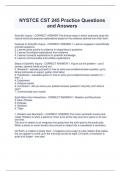
-
NYSTCE CST 245 Practice Questions and Answers
- Exam (elaborations) • 8 pages • 2024
- Available in package deal
-
- $13.49
- + learn more
NYSTCE CST 245 Practice Questions and Answers Scientific Inquiry - CORRECT ANSWER-The diverse ways in which scientists study the natural world and propose explanations based on the evidence derived from their work. Features of Scientific Inquiry - CORRECT ANSWER-1. Learner engages in scientifically oriented questions 2. Learner gives priority to evidence in responding to questions 3. Learner formulates explanations from evidence 4. Learner connects explanations to scientific knowledge...
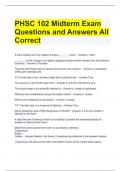
-
PHSC 102 Midterm Exam Questions and Answers All Correct
- Exam (elaborations) • 8 pages • 2024
- Available in package deal
-
- $12.49
- + learn more
PHSC 102 Midterm Exam Questions and Answers All Correct A solar eclipse can only happen during a _______ moon. - Answer-c. New ________ is the change in an object's apparent position when viewed from two different locations. - Answer-b. Parallax That fact that Polaris will not always be the pole star is due to: - Answer-a. precession shifting the celestial pole. T/F A solar day is four minutes longer than a sidereal day. - Answer-True The seasons of the Earth result from: - Answ...
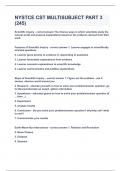
-
NYSTCE CST MULTISUBJECT PART 3 (245)|UPDATED&VERIFIED|100% SOLVED|GUARANTEED SUCCESS
- Exam (elaborations) • 11 pages • 2023
- Available in package deal
-
- $16.99
- + learn more
Scientific Inquiry The diverse ways in which scientists study the natural world and propose explanations based on the evidence derived from their work. Features of Scientific Inquiry 1. Learner engages in scientifically oriented questions 2. Learner gives priority to evidence in responding to questions 3. Learner formulates explanations from evidence 4. Learner connects explanations to scientific knowledge 5. Learner communicates and justifies explanations Steps of Scientific...
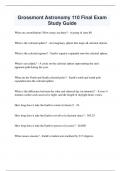
-
Grossmont Astronomy 110 Final Exam Study Guide
- Exam (elaborations) • 21 pages • 2024
- Available in package deal
-
- $13.99
- + learn more
What are constellations? How many are there? - A group of stars.88 What is the celestial sphere? - An imaginary sphere that maps all celestial objects. What is the celestial equator? - Earth's equator expanded onto the celestial sphere. What is an ecliptic? - A circle on the celestial sphere representing the sun's apparent path during the year. What are the North and South celestial poles? - Earth's north and south pole expanded onto the celestial sphere. What is the difference...
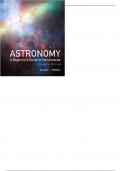
-
Test Bank For Astronomy A Beginners Guide to the Universe 7th edition by Chaisson
- Exam (elaborations) • 413 pages • 2023
-
- $32.64
- + learn more
Chapter 0 Charting the Heavens: The Foundations of Astronomy 1) Right ascension in the sky is very similar to latitude on the Earth. Answer: FALSE Diff: 1 Section Ref.: 0.1 2) Latitude and right ascension are coordinate systems used to find objects on the celestial sphere. Answer: FALSE Diff: 1 Section Ref.: 0.1 3) The celestial sphere is divided into 88 modern constellations. Answer: TRUE Diff: 1 Section Ref.: 0.1 4) In the sky, declination is measured in degrees north or south of th...

-
Science Praxis 5005 form 2 questions and answers 100% pass
- Exam (elaborations) • 14 pages • 2023
- Available in package deal
-
- $9.99
- + learn more
Science Praxis 5005 form 2 questions and answers 100% pass Which of the following is a chemical change? A.Burning wood B.Melting butter C.Breaking glass D.Tearing paper A.Burning wood The magnitude of which of the following can be measured using the Richter scale? A.Tornadoes B.Hurricanes C.Tsunamis D.Earthquakes D.Earthquakes Which of the following characteristics is (are) unique to mammals? A.A bony endoskeleton B.Milk-producing glands C.A vertebral column D.Circulating blood cell...
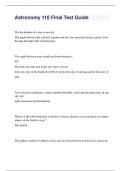
-
Astronomy 110 Final Test Guide
- Exam (elaborations) • 87 pages • 2024
- Available in package deal
-
- $15.99
- + learn more
The declination of a star in our sky The angle between the celestial equator and the star, measured along a great circle Passing through both celestial poles. The angle between your zenith and your horizon is 90°. The Sun rises due east in the sky when viewed from any site on the Earth, but ONLY on the first day of spring and the first day of fall. Two celestial coordinates, which together describe a star's position precisely in our sky, are: right ascension and declination ...
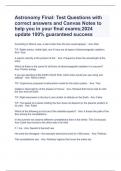
-
Astronomy Final: Test Questions with correct answers and Canvas Notes to help you in your final exams;2024 update 100% guaranteed success
- Exam (elaborations) • 8 pages • 2024
-
- $14.99
- + learn more
Astronomy Final: Test Questions with correct answers and Canvas Notes to help you in your final exams;2024 update 100% guaranteed success According to Wien's Law, a star cooler than the Sun would appear: Ans- Red T/F: Radio waves, visible light, and X-rays are all types of electromagnetic radiation. Ans- True A wave's velocity is the product of the: Ans- Frequency times the wavelength of the wave Which of these is the same for all forms of electromagnetic radiation in a vac...

Did you know that on average a seller on Stuvia earns $82 per month selling study resources? Hmm, hint, hint. Discover all about earning on Stuvia


